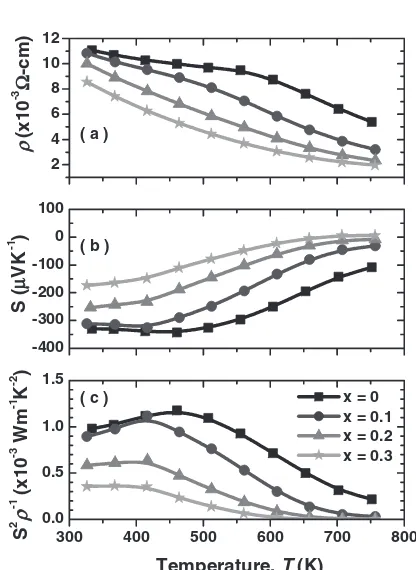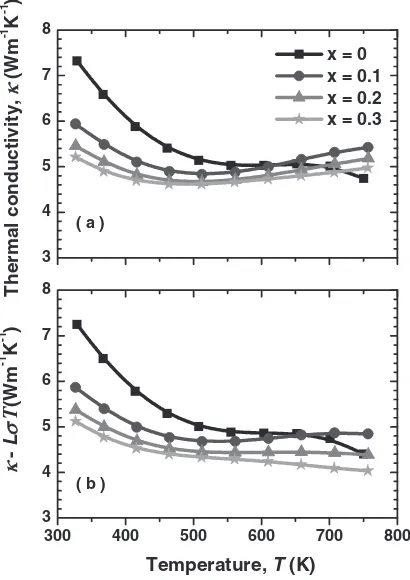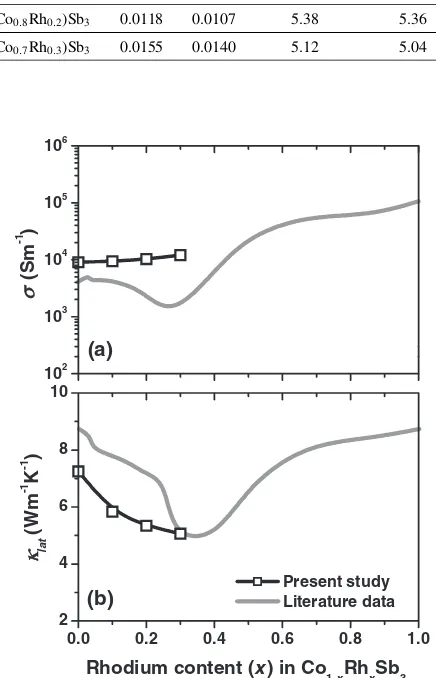Effect of Rh Substitution for Co on the Thermoelectric Properties of CoSb
3Adul Harnwunggmoung
1;2, Ken Kurosaki
1, Anek Charoenphakdee
1;2,
Aikebaier Yusufu
1, Hiroaki Muta
1and Shinsuke Yamanaka
1;31
Division of Sustainable Energy and Environmental Engineering, Graduate School of Engineering, Osaka University, Suita 565-0871, Japan
2Faculty of Science and Technology, Rajamangala University of Technology Suvarnabhumi,
60 Moo 3, Asian Highway, Huntra Phranakhon Si Ayutthaya 13000, Thailand
3Research Institute of Nuclear Engineering, University of Fukui, Fukui 910-8507, Japan
CoSb3is known as a skutterudite compound that could exhibit high thermoelectric figure of merit. However, the thermal conductivity of
CoSb3is relatively high. In order to enhance the thermoelectric performance of this compound, we tried to reduce the thermal conductivity of
CoSb3 by substitution of Rh for Co. The polycrystalline samples of (Co1xRhx)Sb3 (x¼0, 0.1, 0.2, and 0.3) were prepared and the
thermoelectric properties such as the Seebeck coefficient, electrical resistivity, and thermal conductivity were measured in the temperature range from room temperature to 750 K. The Rh substitution for Co reduced the lattice thermal conductivity, due to the alloying scattering effect. The minimum value of the lattice thermal conductivity was 4 Wm1K1at 750 K obtained for (Co
0:7Rh0:3)Sb3.
[doi:10.2320/matertrans.E-M2010808]
(Received November 20, 2009; Accepted February 28, 2010; Published April 15, 2010)
Keywords: thermoelectric, skutterudite, CoSb3, rhodium, thermal conductivity, electrical resistivity, Seebeck coefficient
1. Introduction
Thermoelectric materials are capable of converting waste heat to usable electricity. The effectiveness of a material for thermoelectric applications is determined by the
dimension-less figure of merit,ZT ¼S2T==, whereS is the Seebeck
coefficient, is the electrical resistivity, is the thermal
conductivity, andTis the absolute temperature.1,2)ZT value
of the materials used in current devices is approximately 1. In
recent years, several classes of bulk materials3,4)with highZT
have been discovered, including filled skutterudites.5–7)
Skutterudite compounds have the compositionMX3where
M is a metal atom such as Co, Rh, or Ir andXrepresents a
pnicogen atom such as P, As, and Sb. These compounds are body-centered cubic with 34 atoms in the unit cell and space group Im3. There are two cages per unit cell in the structure. When the third atom incorporates into the cage, the formula
of the compounds turns out to be RM4X12, whereRis most
often a rare-earth element, called filled-skutterudite structure.
The R atom is bonded weakly with the other atoms and
rattles. Therefore, the introduction ofRatoms into the cages
of the skutterudites is an effective method of reducing the lattice thermal conductivity.
In addition to the rattling effect, the lattice thermal conductivity could be reduced by the alloy scattering effect. The alloying can reduce the lattice thermal conductivity by the point defect phonon scattering while giving little influence on the electrical transport, because it does not introduce charge disorder in the crystal lattices. For
example, in the systems of Si-Ge alloy,8) (Zr,Hf)NiSn,9)
and Ti(Co,Rh)Sb,10) the reduction of the lattice thermal
conductivity through the alloy scattering effect have been achieved.
In the CoSb3 system, the thermoelectric properties of
Co(Sb,As)311)and (Co,Rh)Sb312)were reported. In Ref. 11),
homogeneous solid solutions of Co(Sb1xAsx)3 (x0:1)
were prepared and the reduction of the lattice thermal conductivity with increasing As concentration was explained by the enhanced point-defect scattering due to mass fluctua-tions and strain field fluctuafluctua-tions as As atoms substitute on the Sb sublattice. On the other hand, in Ref. 12), a series of
solid solutions of (Co1xRhx)Sb3(0x1:0) was prepared
and the thermoelectric properties were measured within the wide range of composition. It was reported in Ref. 12) that the alloyed compounds resulted in dropping significantly their lattice thermal conductivity and electrical conductivity,
especially for the composition ofxranging between 0.2 and
0.5.
The purposes of the present study are (1) to prepare
homogeneous solid solutions of (Co1xRhx)Sb3(x0:3), (2)
to investigate the relationships between the composition and the electrical conductivity or lattice thermal conductivity, and (3) to compare the obtained results with the literature data reported in Ref. 12). Results of such studies have been presented in the present paper.
2. Experiment
The polycrystalline samples of (Co1xRhx)Sb3(x¼0, 0.1, 0.2, and 0.3) were prepared from Co (99%), Rh (99.9%), and Sb (99.9%) chunks by direct reactions in sealed silica tubes. The obtained ingots were crushed into fine powders, followed by hot-pressing in graphite dies under the pressure of 45 MPa at 973 K for 4 h in an argon flow atmosphere. The obtained samples were characterized with a powder X-ray diffraction
(XRD) method using CuKradiation at room temperature.
The sample microstructure was observed by a scanning electron microscopy (SEM). The chemical composition of the samples was determined with an energy-dispersive X-ray (EDX) analysis in vacuum at room temperature. The density of the bulk samples was calculated based on the measured
weight and dimensions. Electrical resistivity () and the
Seebeck coefficient (S) were measured by using a commer-cially available apparatus (ULVAC, ZEM-1) in a He
atmo-sphere. Thermal conductivity () was evaluated from thermal
diffusivity (), heat capacity (Cp), and sample density (d)
based on the relationship¼Cpd. The thermal diffusivity
was measured by the laser flash technique in a vacuum using a commercially available apparatus (ULVAC TC-7000). The thermoelectric properties were evaluated from room temper-ature to 750 K.
3. Results and Discussion
The powder XRD patterns of the polycrystalline samples
of (Co1xRhx)Sb3 (x¼0, 0.1, 0.2, and 0.3) are shown in
Fig. 1, together with the literature data of CoSb3.13) Small
peaks derived from impurity phases (mainly CoSb2) were
observed in the XRD patterns as shown in circles. The lattice parameters of the skutterudite phase calculated from the XRD patterns are summarized in Table 1. It was confirmed
that the lattice parameter increased linearly with increasingx,
following the Vegard law. It was observed in the SEM and EDX mapping images of the samples that there were no segregation regions and Co, Rh, and Sb distributed homoge-neously throughout the sample surface. The sample densities are summarized in Table 1. Very high-density samples (99% of the theoretical density) were obtained in the present study. As summarized in Table 1, the chemical compositions of the samples determined through the quantitative EDX analyses were slightly Sb-rich and Rh-poor compared with the starting compositions.
The electrical properties of the polycrystalline samples
of (Co1xRhx)Sb3 (x¼0, 0.1, 0.2, and 0.3) are shown in
Figs. 2(a)–(c). The electrical resistivity () of the samples
decreased with temperature in the whole temperature range as shown in Fig. 2(a), indicating that the semiconductor-like
behavior. Thevalues decreased with increasing Rh content,
x. The Seebeck coefficient (S) values were negative and the
absolute values decreased with both temperature and Rh
content, as shown in Fig. 2(b). Especially, sign of theSof the
(Co0:7Rh0:3)Sb3 sample turned from negative to positive at
high temperature. This indicates that the carrier has mixed
conduction mechanism in high temperature region. The
power factor (S21) data of the samples are plotted in
Fig. 2(c) as a function of temperature. Unfortunately, the
power factor was decreased by substituting Rh for Co. CoSb3
indicated the maximum value of the power factor to be
1.2 mWm1K2 at around 450 K.
It is well known that the total thermal conductivity (total)
of solids is mainly composed of two components: the lattice
term (lat) and the electronic term (el). We roughly estimated
the el based on the Wiedemann-Franz relation using the
electrical conductivity (¼1=) data and the Lorenz
number (L¼2:45108WK2), i.e.
el¼LT, and the
lat was obtained by subtracting the el from thetotal. The
temperature dependences of thetotal and thelat(¼total
LT) of the polycrystalline samples of (Co1xRhx)Sb3
(x¼0, 0.1, 0.2, and 0.3) are shown in Fig. 3. It was
10 20 30 40 50 60
Literature data (CoSb3) CoSb2
Intensity (arb.unit)
Diffraction angle, 2θ (degree, Cu Kα) CoSb3
(Co0.9Rh0.1)Sb3 (Co0.8Rh0.2)Sb3 (Co0.7Rh0.3)Sb3
Fig. 1 Powder XRD patterns of the polycrystalline samples (Co1xRhx)Sb3(x¼0, 0.1, 0.2, and 0.3), together with the peak positions
[image:2.595.55.282.71.240.2]calculated from the crystal structure of CoSb3.
Table 1 Lattice parameter, sample bulk density, and chemical composition of (Co1xRhx)Sb3(x¼0, 0.1, 0.2, and 0.3).
xin (Co1xRhx)Sb3
0 0.1 0.2 0.3 Lattice parameter a(nm) 0.9034 0.9051 0.9064 0.9080 Theoretical density dth(g cm3) 7.64 7.67 7.72 7.76
Measured density dexp(g cm3) 7.63 7.60 7.65 7.73
Relative density dexp=dth100(%) 99 99 99 99
Chemical composition Co 24 22 20 18 determined through Rh — 2 4 6 the EDX analysis (at%) Sb 76 76 76 76
300 400 500 600 700 800
0.0 0.5 1.0 1.5 -400 -300 -200 -100 0 100 2 4 6 8 10 12
( c )
S
ρ
2-1 (
x10
-3 Wm -1 K -2 )
Temperature, T (K)
x = 0 x = 0.1 x = 0.2 x = 0.3 ( b )
S (
µ
VK
-1 )
( a )
(x10
ρ
-3 Ω
-cm)
Fig. 2 Temperature dependences of the electrical properties of the polycrystalline samples (Co1xRhx)Sb3 (x¼0, 0.1, 0.2, and 0.3); (a)
electrical resistivity, (b) Seebeck coefficient S, and (c) power factor
[image:2.595.306.550.96.220.2] [image:2.595.321.529.238.523.2]confirmed that thelatwas predominant at low temperatures,
whereas the contribution of the el became large at high
temperatures. The lat of (Co1xRhx)Sb3 decreased with
increasing temperature and also decreased with increasing Rh
content, x, indicating that the alloying between Co and Rh
was effective to reduce thelat.
Next, in order to evaluate the effect of Rh substitution for
Co on thelatof CoSb3quantitatively, the phonon scattering
parameters were calculated based on a point defect scattering
theory,14–16)in which only the phonon-phonon scattering and
the phonon-point defect scattering were taking into consid-ered and the boundary scattering was neglected. In the
present case, the relaxation time total can be expressed as
follows: 1 total ¼ 1 D þ 1 P ; ð1Þ
where D and P are the relaxation times for the
phonon-phonon and the phonon-phonon-point defect scatterings, respectively.
DandPcan be described by using the phonon frequency!
as follows:15)
1 D
¼A!4; ð2Þ
1
P
¼CT!2: ð3Þ
The value ofAis independent of temperature, which can be
expressed by the following equation:16)
A¼
3
4v3
X
i
M;iþS;i
¼
3
43
X
i
xið1xiÞ
MiM
M
2
þ" rir r
2
" #
; ð4Þ
where 3 is the average atomic volume, v is the phonon
velocity,xiis the fractional concentration of the componenti,
Mi is the atomic mass of the substituted element,M is the
average atomic mass,riis the atomic radius of the substituted
element, andris the average atomic radius.M andSare
the phonon scattering parameters due to mass and strain-field
fluctuations, respectively. Generally, the parameter " is
regarded as the adjustable parameter, normally ranging from
10 to 100.9,10) On the other hand, the value of C is
proportional to the reciprocal of the absolute temperature,
which can be expressed by the following equation:15)
C¼ k
2
B 22hT
1
CoSb3
; ð5Þ
wherekB, ,h, andCoSb3are the Boltzmann constant, Debye
temperature, the Planck constant divided by 2, and the
lattice thermal conductivity of pure CoSb3. By using the
above-mentioned parameters, thelatof the alloyed materials
is expressed as follows:15)
lat¼ kB
22ðACTÞ12
tan1 kB h A CT 1 2 " # : ð6Þ
In the present study, the average sound velocityvaveof CoSb3
was used as the phonon velocityv. In order to evaluate the
vaveand , the samples were bonded to a 5 MHz longitudinal
or shear sound wave echogenic transducer and the
longi-tudinal (vl) and shear (vs) sound velocities were measured.
The measurements were performed at room temperature
in air. From the measured vl and vs the vave and were
calculated based on the following equations:
vave¼ 1 3
1 vl3
þ 2
vs3
1=3
; ð7Þ
¼ h
kB 3N
4V
1
3
vave; ð8Þ
whereNis the number of atoms in a unit cell andVis the unit
cell volume. In the present study, the vave and the Debye
temperature were evaluated to be 3684 ms1 and 320 K,
respectively.
The calculated lattice thermal conductivity (calc) for
(Co1xRhx)Sb3 (x¼0, 0.1, 0.2, and 0.3) are summarized in
Table 2, together with the experimental lattice thermal
conductivity (lat at 330 K). In calculating the lat, the
adjustable parameter " was determined by fitting. The
parameter"is a phenomenological adjustable parameter that
characterizes anharmonicity of the lattice. Although the value of "15was reported in the Co(Sb1xAsx)3 system,11)the
value of "¼48 was determined in the (Co1xRhx)Sb3
system.
It was confirmed that the calculated lat were well
consistent with the experimental data. TheMandSvalues
are also summarized in Table 2. The values of S andM
were similar to each other, indicating that the strain-field
300 400 500 600 700 800
3 4 5 6 7 8 3 4 5 6 7 8
( b )
κ - L σ T (Wm -1 K -1 )
Temperature, T (K)
x = 0 x = 0.1 x = 0.2 x = 0.3
( a )
Thermal conductivity,
κ
(Wm
-1 K -1 )
Fig. 3 Temperature dependences of the thermal conductivities of the polycrystalline samples (Co1xRhx)Sb3(x¼0, 0.1, 0.2, and 0.3); (a) total
(measured) thermal conductivitytotaland (b) lattice thermal conductivity
lat (¼totalLT) where L is the Lorentz number (¼2:45
108WK2), is the electrical conductivity (¼1=), and T is the
[image:3.595.67.272.74.364.2]fluctuation effect and the mass fluctuation effect were
comparable in reducing the lat of CoSb3 by substituting
Rh for Co to the same degree.
Figure 4 shows the relationships between electrical
con-ductivity, or lattice thermal conductivity, lat for
(Co1xRhx)Sb3 at around room temperature and Rh content,
x. In this figure, the literature data12) are also shown for
comparison (gray lines). Although it was reported12)that both
and lat for (Co1xRhx)Sb3 significantly decreased in the
composition range betweenx¼0:2and 0.5, such trend was
not observed in the present study. That is, the slightly
increased and thelatgradually decreased with Rh content,x.
Unfortunately, the authors did not have a clear solution to this difference between the previous and the present results on the composition dependences of the transport properties of
(Co1xRhx)Sb3. However, it can be said that the present
results on the reduction of the lat with increasing Rh
concentration was explained by the well-known alloy scattering effect between Co and Rh atoms.
Finally, the temperature dependence of the ZT of the
polycrystalline samples of (Co1xRhx)Sb3 (x¼0, 0.1, 0.2,
and 0.3) is shown in Fig. 5. Since the Rh substitution for Co
caused decrease in thelatbut further decrease in the power
factor, theZT values decreased with increasing Rh content.
The maximumZT obtained in the present study was 0.15 at
around 500 K for CoSb3.
4. Summary
In the present study, the polycrystalline samples of (Co1xRhx)Sb3 (x¼0, 0.1, 0.2, and 0.3) were prepared and
the thermoelectric properties were examined. All samples indicated single phase of the skutterudite structure. The
Seebeck coefficient (S) values were negative. Both the
electrical resistivity () and the absoluteSvalues decreased
with increasing Rh content. The power factor (S21) was
decreased by substituting Rh for Co. On the other hand, the
lattice thermal conductivity (lat) decreased with increasing
Rh content due to the alloy scattering effect between Co and Rh. Unfortunately, the Rh substitution decreased the
dimen-sionless figure of merit (ZT). The maximumZT obtained in
the present study was 0.15 at around 500 K for CoSb3.
Acknowledgements
This work was supported in part by a Grant-in-Aid for Scientific Research (No. 21760519) from the Ministry of Education, Culture, Sports, Science and Technology, Japan. Additional support was kindly provided by the Wakasa Wan Energy Research Centre, The Thermal & Electric Energy Technology Foundation, the Association for the Progress of New Chemistry, KRI Inc., and the Murata Science Foundation.
REFERENCES
1) T. M. Tritt and M. A. Subramanian: Mater. Res. Soc. Bull.31(2006) 188–194.
2) CRC Handbook of Thermoelectrics, ed. by D. W. Rowe (CRC, New York, 1995).
3) J. P. Heremans, V. Jomovic, E. S. Toberer, A. Saramat, K. Kurosaki, A. Charoenphakdee, S. Yamanaka and G. J. Snyder: Science321(2008)
0.0 0.2 0.4 0.6 0.8 1.0
2 4 6 8 10
κlat
(Wm
-1 K -1 )
Rhodium content (x) in Co
1-xRhxSb3 Present study Literature data 102
103 104 105 106
(b) (a)
σ
(Sm
-1 )
Fig. 4 (a) Electrical conductivity,and (b) lattice thermal conductivity,
latvs. Rh content,xfor (Co1xRhx)Sb3at around room temperature.
300 400 500 600 700 800
0.00 0.02 0.04 0.06 0.08 0.10 0.12
x = 0 x = 0.1 x = 0.2 x = 0.3
Temperature, T (K)
ZT
Fig. 5 Temperature dependences of the dimensionless figure of meritZT
[image:4.595.319.534.74.230.2]of the polycrystalline samples (Co1xRhx)Sb3(x¼0, 0.1, 0.2, and 0.3).
Table 2 Phonon scattering parameters due to mass and strain-field fluctuations (M and S), experimental (lat at 330 K) and calculated
(calc) lattice thermal conductivities of (Co1xRhx)Sb3(x¼0, 0.1, 0.2, and
0.3); TheSwas calculated under the adjustable parameter"¼48.
Composition M S latat 330 K
(Wm1K1)
calc
(Wm1K1)
CoSb3 7.2 7.2
(Co0:9Rh0:1)Sb3 0.0066 0.0060 5.87 5.95
(Co0:8Rh0:2)Sb3 0.0118 0.0107 5.38 5.36
[image:4.595.44.291.114.195.2] [image:4.595.58.276.164.503.2]554–557.
4) K. Kurosaki, A. Kosuga, H. Muta, M. Uno and S. Yamanaka: Appl. Phys. Lett.87(2005) 061919-1–061919-3.
5) B. C. Sales, D. Mandrus and R. K. Williams: Science272(1996) 1325– 1328.
6) X. Y. Zhao, X. Shi, L. D. Chen, W. Q. Zhang, W. B. Zhang and Y. Z. Pei: J. Appl. Phys.99(2006) 053711-1–053711-4.
7) H. Li, X. Tang, Q. Zhang and C. Uher: Appl. Phys. Lett.94(2009) 102114-1–102114-3.
8) E. F. Steigmeier and B. Abales: Phys. Rev.136(1964) A1149–A1155. 9) J. Yang, G. P. Meisner and L. Chen: Appl. Phys. Lett.85(2004) 1140–
1142.
10) M. Zhou, L. Chen, W. Zhang and C. Feng: J. Appl. Phys.98(2005) 013708-1–013708-5.
11) Z. Zhou, C. Uher, A. Jewell and T. Caillat: Phys. Rev. B71(2005) 235209-1–235209-6.
12) K. T. Wojciechowski: J. Alloy. Compd.439(2007) 18–24.
13) Z. Wegrzyn, A. Malecki, M. Bucko and K. T. Wojciechowski: Appl. Crystallogr.18(2001) 46.
14) P. G. Klemens: Proc. Phys. Soc.A68(1955) 1113–1128.
15) J. Callaway and Hans C. von Baeyer: Phys. Rev.120(1960) 1149– 1154.


